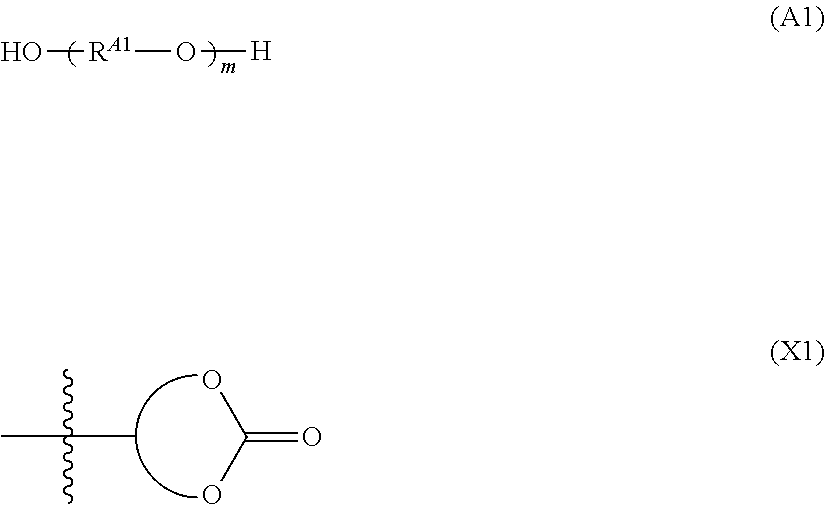Polycarbonate polyol and polyurethane
a polyurethane and polyurethane technology, applied in the field of polycarbonate polyol and polyurethane, can solve the problems of poor flexibility, elongation, bending or elasticity recovery of polyurethane, poor “texture”, etc., and achieve excellent solvent resistance, high mechanical strength, and high flexibility
- Summary
- Abstract
- Description
- Claims
- Application Information
AI Technical Summary
Benefits of technology
Problems solved by technology
Method used
Image
Examples
examples
[0277]The present invention will now be described more concretely by way of Examples and Comparative Examples; however, the present invention is not restricted thereto within the gist of the present invention.
[Evaluation Methods]
[0278]Polycarbonate polyols and polyurethanes obtained in the below-described Examples and Comparative Examples were evaluated by the following methods.
[Evaluation of Polycarbonate Polyols]
[0279]The subject polycarbonate diol was dissolved in CDCl3, and 400-MHz 1H-NMR spectroscopy (AL-400, manufactured by JEOL Ltd.) was performed to identify phenoxy groups, a diol(s), a branched alcohol(s) and a phenol(s) based on the signal positions of the respective components, after which the content of each component was calculated from integral values. The detection limits in this process were 100 ppm for the weight of a phenol with respect to the weight of the whole sample, and 0.1% by weight for dihydroxy compounds such as the compound represented by Formula (A) and ...
example i-1
[0305]To a 5-L glass separable flask equipped with a stirrer, a distillate trap and a pressure adjusting device, 786.1 g of diethylene glycol (DEG), 744.7 g of triethylene glycol (TEG), 25.5 g of trimethylolpropane (TMP), 2,525.0 g of diphenyl carbonate (DPC) and 6.3 mL of an aqueous magnesium acetate tetrahydrate solution (concentration: 8.4 g / L, magnesium acetate tetrahydrate: 53 mg) were added, followed by purging with nitrogen gas. The contents were heat-dissolved by raising the internal temperature to 160° C. with stirring. Subsequently, after the pressure was reduced to 24 kPa over a period of 2 minutes, the reaction was allowed to proceed for 90 minutes while removing phenol out of the system. Then, the reaction was continued while reducing the pressure to 9.3 kPa over a period of 90 minutes and further to 0.7 kPa over a period of 30 minutes, after which the temperature was raised to 170° C. and the reaction was allowed to proceed for another 2 hours while removing phenol and...
example i-2
[0308]To a 1-L glass separable flask equipped with a stirrer, a distillate trap and a pressure adjusting device, 231.8 g of diethylene glycol (DEG), 219.6 g of triethylene glycol (TEG), 7.5 g of trimethylolpropane (TMP), 741.2 g of diphenyl carbonate (DPC) and 1.9 mL of an aqueous magnesium acetate tetrahydrate solution (concentration: 8.4 g / L) were added, followed by purging with nitrogen gas. The contents were heat-dissolved by raising the internal temperature to 160° C. with stirring. Subsequently, after the pressure was reduced to 24 kPa over a period of 2 minutes, the reaction was allowed to proceed for 90 minutes while removing phenol out of the system. Then, the reaction was continued while reducing the pressure to 9.3 kPa over a period of 90 minutes and further to 0.7 kPa over a period of 30 minutes, after which the temperature was raised to 170° C. and the reaction was allowed to proceed for another 15 hours while removing phenol and unreacted dihydroxy compounds out of the...
PUM
| Property | Measurement | Unit |
|---|---|---|
| hydroxyl value | aaaaa | aaaaa |
| temperature | aaaaa | aaaaa |
| temperature | aaaaa | aaaaa |
Abstract
Description
Claims
Application Information
 Login to View More
Login to View More - R&D
- Intellectual Property
- Life Sciences
- Materials
- Tech Scout
- Unparalleled Data Quality
- Higher Quality Content
- 60% Fewer Hallucinations
Browse by: Latest US Patents, China's latest patents, Technical Efficacy Thesaurus, Application Domain, Technology Topic, Popular Technical Reports.
© 2025 PatSnap. All rights reserved.Legal|Privacy policy|Modern Slavery Act Transparency Statement|Sitemap|About US| Contact US: help@patsnap.com



